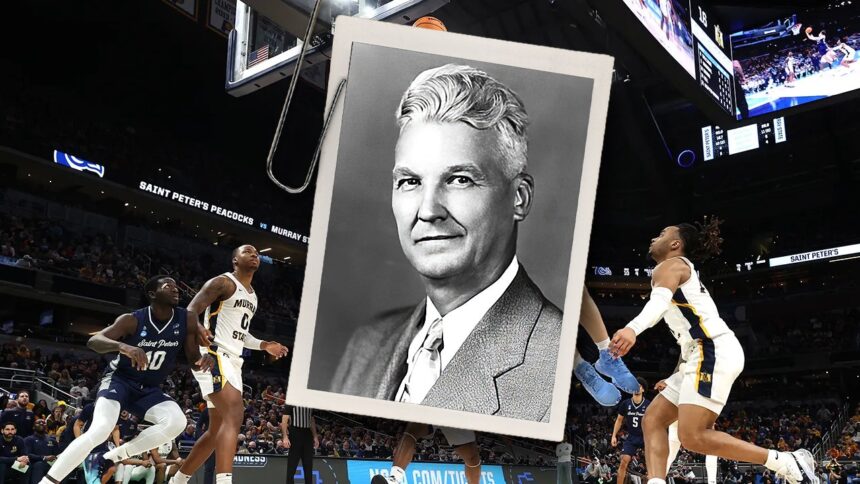March Insanity afflicts tens of millions of American sports activities followers annually throughout springtime.
Victims of the fever exhibit spontaneous outbreaks of basketball jargon, cry over busted brackets and name in sick to work on Thursdays and Fridays.
There is no such thing as a identified treatment for March Insanity.
However basketballogists know its origin. The illness was first recognized in 1939 by Illinois highschool sports activities administrator Henry “H.V.” Porter.
FOX NATION’S NEW SERIES ‘MEET THE AMERICAN WHO’ TELLS OF ORDINARY AMERICANS WHO GAVE US EXTRAORDINARY INNOVATIONS
He was as Illinois as a horseshoe sandwich. And he beloved highschool basketball.
“When the March Insanity is on him, midnight jaunts of 100 miles on successive nights make him much more alert the following day,” Porter wrote romantically of the state’s exuberant highschool basketball followers throughout the raucous statewide event in March 1939.

H.V. Porter coined the phrase “March Insanity” as a highschool sports activities administrator in Illinois in 1939. He entered the Basketball Corridor of Fame in 1960. (Illinois Excessive College Affiliation)
It’s the first-known use of a phrase now related to the wildly widespread NCAA males’s basketball event — first held, coincidentally, in March 1939, simply as Porter was penning his “March Insanity” essay for “Illinois Excessive College Athlete” journal.
A long time later, the NCAA adopted and trademarked the phrase.
“Porter was a visionary. He was forward of his time.” — Bruce Firchau, Basketball Museum of Illinois
March Insanity swept over the hardwood courts of small-town Center America lengthy earlier than it emerged from the boardrooms of company America. It’s now a well-recognized catchphrase in wider American tradition past sports activities.
Porter, its creator, had a poet’s soul, an affinity for alliteration and a ardour for heartland highschool hoops.

Ryan Kalkbrenner, #11 of the Creighton Bluejays, wins the opening tip over Flo Thamba #0 of the Baylor Bears within the second spherical of the 2023 NCAA Males’s Basketball Match at Ball Area on March 19 in Denver, Colorado. (Jamie Schwaberow/NCAA Pictures through Getty Pictures)
“He was a visionary. He was forward of his time,” Bruce Firchau, chairman of The Basketball Museum of Illinois, advised Fox Information Digital.
Porter captured the sports activities spirit of small-town America within the Nice Despair.
“The annual event of highschool boys basketball groups, sponsored by the Illinois Excessive College Affiliation, grew from a small invitational affair in 1908 to a statewide establishment with over 900 colleges by the late Thirties,” the affiliation writes in its on-line historical past.
MEET THE AMERICAN WHO DESIGNED THE EMPIRE STATE BUILDING, NEW YORK CITY NATIVE ARCHITECT WILLIAM F. LAMB
“In a time earlier than tv, earlier than the faculty sport grew to become widespread with the typical fan, earlier than skilled leagues had established a foothold within the nation’s giant cities, basketball fever had already reached epidemic proportions within the Land of Lincoln.”
Porter did not struggle the fever. He helped unfold it.
Born with basketball
Henry Van Arsdale Porter was born in Manito, Illinois, on Oct. 2, 1891.
The sport of basketball was born two months later, in December 1891, created by bodily schooling trainer Dr. James Naismith on the Springfield, Massachusetts YMCA, now Springfield Faculty.

The primary basketball staff, consisting of 9 gamers and their coach on the steps of the Springfield Faculty Gymnasium in 1891 are proven. Dr. Naismith is in civilian garments and grouped about him are left to proper from again row: John G. Thompson, Eugene S. Libby, Edwin P. Ruggles, William R. Chase, and T. Duncan Patton. Within the middle row are Frank Mahan and Dr. James Naismith. Within the entrance row is Finlay G. MacDonald, William H. Davis and Lyman W. Archibald. (Getty Pictures)
Porter’s mother and father, Alfred Willis and Laura Beckwith (Hyers) Porter, have been each Illinois natives.
At the very least three earlier generations of Porter’s household known as Illinois dwelling. One in all his great-grandmothers was from a New Jersey household of pioneers who settled within the Midwest.
Porter spent his life working in highschool athletics whereas spreading the gospel of the all-American sport born beside him.
“Tools inventor, rule maker, highschool coach and athletic administrator, Henry Porter’s improvements have been very important to the evolution of basketball.” — Basketball Corridor of Fame
“Tools inventor, rule maker, highschool coach and athletic administrator, Henry Porter’s improvements have been very important to the evolution of basketball,” says the Naismith Memorial Basketball Corridor of Fame.
CLICK HERE TO SUBSCRIBE TO FOX NATION
“Porter printed the primary highschool rulebook, standardizing the sport throughout the nation,” in 1936, the Corridor provides, and “served as the primary consultant for top colleges on the Nationwide Basketball Guidelines Committee.”
Porter labored with sports activities producers to provide molded leather-based basketballs to exchange the cumbersome and hard-to-dribble laced balls used within the early years of the game.

An early-era laced basketball, utilized by Mount Vernon Excessive College in its 1920 Illinois state championship season. H.V. Porter, the Illinois administrator who coined “March Insanity,” additionally pioneered the usage of molded basketballs, making laced variations out of date. (Mount Vernon Excessive College/The Basketball Museum of Illinois)
“Underneath his management, excessive colleges adopted the brand new ball in 1938, and later within the Nineteen Forties, adopted an excellent higher composite-molded basketball,” the Corridor of Fame notes.
His affect unfold nationwide. However Porter’s coronary heart by no means left the small-town courts of Illinois or these fans who beloved highschool basketball as a lot as he did.
MEET THE AMERICAN WHO FOUNDED PICKLEBALL, THE FASTEST GROWING SPORT IN THE NATION
“Homo of the Hardwood Courtroom is a hardy specie (sic),” Porter wrote in his influential 1939 essay beneath the headline, “March Insanity.”
His description of basketball followers of the Nice Despair nonetheless hits nothing however web right this moment.
“The thud of the ball on the ground, the slap of the arms on leather-based, the swish of the online are music to his ears … He’s biased, noisy, fidgety, boastful and unreasonable — however we love him for his imperfections.”

Program from the 1952 Illinois Excessive College Affiliation boys basketball event. Highschool basketball loved such feverish fan assist in Illinois, it was dubbed “March Insanity” in 1952. (The Basketball Museum of Illinois)
Porter left his place as an government with the Illinois Excessive College Affiliation in 1940, the 12 months after he wrote his essay, to turn into government secretary of the Nationwide Federation of State Excessive College Associations.
He held the place till 1958, serving to unfold the idea of “March Insanity” to highschool basketball tournaments across the nation.
He adopted up his 1939 “March Insanity” essay with a somber however extra highly effective 1942 poem: “The Basketball Ides of March.”
He wrote it as World Struggle II drew curiosity, and younger males, away from the basketball courts of the American heartland and into the battlefields of Europe and Asia.
“Eagles fly and heroes die/beneath some overseas arch/let their sons thread the place hate is lifeless/in a contented Insanity of March.” — H.V. Porter throughout WWII
“In 1,000,000 lives the place freedom thrives/And liberty lingers nonetheless/How eagles fly and heroes die/beneath some overseas arch/let their sons thread the place hate is lifeless/in a contented Insanity of March.”
Land of iron hoops
Broadcaster Brent Musburger helped popularize Porter’s “March Insanity” earlier than a nationwide viewers whereas protecting the NCAA event for tv.

Sportscaster Brent Musburger helped popularize the phrase “March Insanity” whereas protecting the NCAA basketball event within the Eighties. He traces its origins to the Illinois highschool basketball event, first described as “March Insanity” in 1939. (Ethan Miller/Getty Pictures)
He first uttered “March Insanity” on air throughout the 1982 NCAA event.
The tourney ended that 12 months when an unknown 19-year-old College of North Carolina freshman hit the successful shot within the championship sport towards Georgetown.
His identify was Michael Jordan.
MEET THE AMERICAN WHO CREATED NASCAR: BILL FRANCE SR., DAYTONA SPEED DEMON AND RACETRACK PIONEER
Musburger traces the phrase he popularized to Porter and to Illinois, the place he labored as a younger reporter within the Nineteen Sixties after graduating from Northwestern.
“At the moment, the Illinois highschool basketball tourney was very a lot greater than (NCAA) March Insanity, which had probably not taken off but,” Musburger, now the face of VSiN Community, advised Fox Information Digital in an interview.

NCAA Closing 4, North Carolina Michael Jordan (No. 23) in motion, making game-winning shot vs. Georgetown, New Orleans, March 29, 1982. The time period “March Insanity” started to achieve recognition on the collegiate stage that 12 months. (Heinz Kluetmeier/Sports activities Illustrated through Getty Pictures)
“Cities within the Midwest lived for highschool basketball.”
The Illinois highschool event was so massive within the Nineteen Sixties that it spawned a madcap TV advert marketing campaign by a Chicago auto vendor beneath the “March Insanity” banner that included tourney scores from across the state.
“I can’t bear in mind the identify of the vendor or the model of autos he was promoting,” Musburger stated. “Nevertheless it was an enormous deal in Chicago within the Nineteen Sixties, particularly with big-city excessive colleges making inroads into the event” — lengthy dominated by small rural colleges.
The broadcaster recalled these enthusiastic adverts and the insanity displayed for Illinois highschool basketball when he started utilizing “March Insanity” to explain the NCAA event.
Small-town March Insanity reached its zenith in Illinois in 1952, when tiny Hebron Excessive College, with a pupil physique of simply 95 youngsters, made all of it the best way to the state finals in Champaign.

Hebron Excessive College star Phil Judson is proven driving with the ball within the 1952 Illinois Excessive College Affiliation boys basketball event. Tiny Hebron Excessive beat a lot bigger colleges to win the state title in 1952. Its stunning success is taken into account an inspiration for “Hoosiers,” a few equally small highschool that beats bigger groups to win the Indiana state title. (The Illinois Excessive College Affiliation)
“Hebron grew to become a basketball group years earlier, a extremely good basketball group,” star of the 1952 staff, Phil “Swish” Judson, advised Fox Information Digital.
Amazon and sports activities superstores did not exist again then. So Hebron’s basketball coach years earlier enlisted a neighborhood blacksmith to forge hoops from iron in order that Hebron youngsters might dangle them from timber or barns and shoot baskets at dwelling.
Swish Judson nonetheless has a type of iron hoops right this moment.
The primitive {hardware} labored. Little Hebron Excessive shocked Illinois basketball by successful the 1952 state title — toppling mighty Quincy Excessive College. With its pupil physique of 1,400 youngsters, Quincy’s highschool was 3 times bigger than the complete city of Hebron.

An early-era laced basketball, utilized by Mount Vernon Excessive College in its 1920 Illinois state championship season. H.V. Porter, the Illinois administrator who coined “March Insanity,” additionally pioneered the usage of molded basketballs, making laced variations out of date. (Mount Vernon Excessive College/The Basketball Museum of Illinois)
Judson and his teammates, together with brother Paul, have been feted by what Firchau of The Illinois Basketball Museum known as “the longest parade in Illinois historical past” — he estimates 80 to 100 miles lengthy.
He can nonetheless chronicle the cavalcade city by city: “From Morris to Yorkville, up 47 by way of Sugar Grove, all the best way up by way of Elgin, by way of Woodstock and across the city sq. twice after they ultimately acquired to Hebron.”
For extra Way of life articles, go to www.foxnews.com/life-style
Years later, the Judson boys have been watching the 1986 film “Hoosiers.”
It is the story of fictional small-town Hickory Excessive College, which miraculously beats a bigger metropolis college to win the state title. “Hoosiers” lore says it was impressed by 1954 Indiana state champion Milan Excessive College.
Nevertheless it struck near dwelling for the 1952 Illinois schoolboy basketball heroes.

Hebron Excessive College, with simply 95 college students, received the Illinois state highschool basketball championship in 1952, toppling groups from a lot bigger colleges on the best way. Illinois basketball fans say it was one of many inspirations for the film “Hoosiers.” (The Basketball Museum of Illinois)
Stated Swish Judson, “A variety of issues that occurred in that movie depicted Hebron.”
Famous Firchau, “Illinois basketball does not take a backseat to anyone, together with Indiana.”
March Insanity retains society on ‘even keel’
Henry Van Arsdale Porter, the person who gave America “March Insanity,” died in St. Petersburg, Florida, on Oct. 27, 1975. He was 84 years previous.
His ashes are interred right this moment at Memorial Park Cemetery in St. Petersburg.
He and his longtime spouse, Grace Kromminga, by no means had kids.

H.V. Porter was inducted into the Basketball Corridor of Fame in 1960, however grew to become finest identified in later years for coining the phrase “March Insanity.” (Illinois Excessive College Affiliation)
However his spirit lives on within the aggressive zeal of American youth every March.
Porter was inducted into the Naismith Memorial Corridor of Fame as the only member of its 1960 and second class, largely for contributions exterior the phrase “March Insanity.”
CLICK HERE TO SIGN UP FOR OUR LIFESTYLE NEWSLETTER
The NCAA event, in the meantime, now bearing the identify he dropped at life, is an American cultural behemoth.
The faculty athletic affiliation gained the rights to “March Insanity” after a protracted authorized struggle with the state of Illinois — the main points of which have by no means been revealed.
“A bit March Insanity could complement and contribute to sanity and assist maintain society on an excellent keel.” — H.V. Porter
“From its humble beginnings to its broadly identified utilization right this moment, the NCAA’s March Insanity trademark represents a helpful asset that the NCAA fiercely protects,” wrote mental property lawyer Josh Gerben.
Added Gerben, “Over 85% of the NCAA’s yearly price range comes from the promoting and advertising and marketing of its three-week basketball event. Consequently, the NCAA has a well-established repute for safeguarding its ‘March Insanity’ emblems, the primary of which was registered again in 1989.”

The St. Peter’s Peacocks go up towards the Murray State Racers throughout the second spherical of the 2022 NCAA Males’s Basketball Match at Gainbridge Fieldhouse on March 19, 2022, in Indianapolis, Indiana. Illinois highschool administrator H.V. Porter, inset, coined the time period “March Insanity.” (Andy Lyons/Getty Pictures; Illinois H.S. Affiliation)
Porter celebrated healthful youthful pursuits on the hardwood in one of the troublesome instances in American historical past, with the Nice Despair lingering for a decade and warfare clouds looming abroad.
He discovered ardour for basketball important to the well being of the nation in instances of disaster.
CLICK HERE TO GET THE FOX NEWS APP
“A bit March Insanity,” Porter wrote on the finish of his March 1939 essay, “could complement and contribute to sanity and assist maintain society on an excellent keel.”
To learn extra tales on this distinctive “Meet the American Who…” sequence from Fox Information Digital, click on right here.







